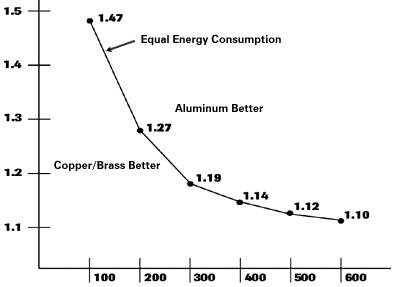But in today's highly sensitive automotive marketplace – where manufacturers want the most environmentally compatible materials and processes for the next generation of cars and trucks – copper together with brass may have far more value owing to the lower life-cycle energy consumption of each metal.
The accompanying charts show why. Calculations are for an identical vehicle, one with a copper/brass radiator, the other with aluminum radiator.
Particularly impressive is the fact that a copper/brass radiator core is far more energy efficient than an aluminum radiator core of equal weight (336 KWh vs. 426 kWh).
With the introduction of advanced, light-weight designs for radiators, life-cycle energy efficiency will be even more favorable. The no-flux, brazed copper/brass radiator is an example.
Now in testing, the breakthrough radiator is more efficient, more durable, and of higher quality than conventionally soldered radiators. Made with special alloys and new technologies such as laser welding, this and other advanced copper/brass radiators are far lighter, yet stronger, than traditional soldered copper/brass radiators. They are also expected to last up to 10 years.
When you combine copper/brass's superior thermal conductivity, corrosion resistance and strength with it's highly favorable life-cycle energy use, virtual 100% recyclability, and exceptionally low energy cost as remanufactured scrap, it becomes clear that the world's oldest known metal will be even better for tomorrow's car and truck radiators.
| Weight Ratio |
 |
| Vehicle Life (in thousands of km) |
| For Copper/Brass and Aluminum Cores of the Same Weight (2.5 kg) | ||
|---|---|---|
| Aluminum 2.5 kg |
Copper/Brass 2.5 kg |
|
| Energy to produce core, kWh | 140 | 50 |
| Lifetime fuel energy, kWh | 286 | 286 |
| Total energy consumed, kWh | 426 | 336 |
| For Cores of Different Weight: Aluminum (2.5 kg), Copper (3.17 kg) | ||
| Aluminum 2.5 kg |
Copper/Brass 3.17 kg |
|
| Energy to produce core, kWh | 140 | 63 |
| Lifetime fuel energy, kWh | 286 | 363 |
| Total energy consumed, kWh | 426 | 426 |
| Vehicle weight | 1400 kg |
| Vehicle life | 200,000 km |
| Gasoline consumption | 8 liters/100 km |
| Gasoline energy | 10 kWh/liter |
| Lifetime gasoline energy consumed per unit of vehicle weight |
|
| Energy to produce core: | Aluminum: 56 kWh/kg Copper: 20 kWh/kg |
